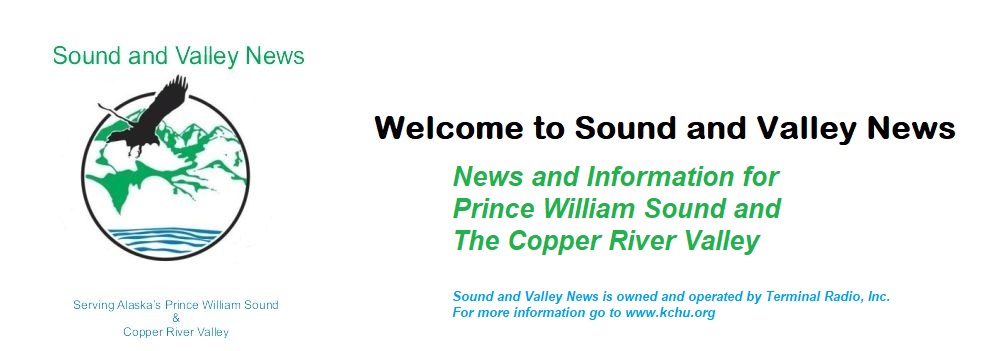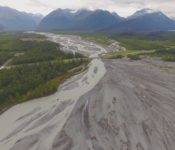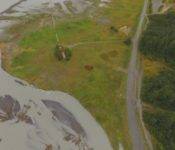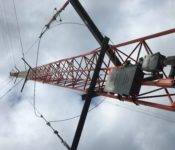
UPDATE from AnneMarie Lain; Senior Planning / GIS Technician, City of Valdez Community and Economic Development
Wednesday, August 18th, Community Development staff contacted KCHU to discuss the proximity of the shifting Valdez Glacier River toward the guide wires that support the KCHU tower. John Anderson, general manager of KCHU, and his tower crew have been assessing the situation on a near-daily basis.
KCHU is the primary and in many cases the only EAS (emergency action service) provider for Valdez and several surrounding communities including: Chenega, Tatitlek, Whittier, Cordova, McCarthy, Ellamar, and maritime operations in the Prince William Sound. Fire Chief George Keeney contacted the State EOC (emergency operations center) to inform them of the threat.
John Anderson has contacted the Alaska Public Broadcasting Commission and Alaska Broadcasting Association to pursue emergency response funding.
On Friday last week, staff met with NRCS (National Resource Conservation Service) representative Brett Nelsen to determine if protection of the KCHU Radio tower qualifies for the EWP program. The Emergency Watershed Protection Program is designed to help communities address watershed impairments that pose imminent threats to lives and property.
Mr. Nelsen will be formalizing a recommendation in favor of funding a project on the Valdez Glacier Stream to protect the KCHU Radio tower. NRCS will have a surveying crew in Valdez in a few weeks to complete a Damage Survey Report that provides a case-by-case investigation of the work necessary to repair or protect a site.
|
|
- The Damage Survey Report is of no cost to the City, there is no obligation for the City to commit to the project until a project proposal and cost-estimate are provided
- NRCS will fund up to 75% of the construction cost of emergency repairs. The remaining 25% must come from a local government agency.
The NRCS is an immediate action funding source. Should the City qualify and choose to accept the terms of funding, engineering will take place this fall so that construction can begin next Spring.
The NRCS is an active federal agency with a home-base in Palmer, Alaska. They have funded and engineered river control and stabilization projects all over the state including McCarthy, Tanana, McGrath, Eagle, and Juneau- to name a few.
Staff continues to coordinate with KCHU and is providing NRCS with needed documentation to pursue funding. Capital Facilities staff continues to monitor the situation on a daily basis. Public Works is prepared to react should the tower need immediate protection.
ORIGINAL STORY
It sounds like the plot to a disaster movie. A beautiful glacial stream running from the mountains to the sea changes course, washes out a road and starts undercutting the ground around a 300 foot radio tower. It’s actually a 285 foot radio tower on a 15 foot rise designed to protect it from flooding. If the water undercuts the 22, 715 pound reinforced concrete piers to which the cables stabilizing the tower are attached, it won’t crush houses and businesses as it would in a disaster movie. It will topple into the ocean, effectively destroying the tower and taking 10,000 watts of AM radio off the air.
KCHU’s AM signal reaches throughout Valdez, up the Richardson Highway up well beyond Thompson Pass, out across Prince William Sound to vessels underway and to various remote locations in the Copper River Valley who can’t pick up FM signals, which are line-of-sight. This makes it vitally important for marine weather and emergency broadcast purposes.
The KCHU tower has been at its site at 240 McKinley Street in Old Town Valdez for over thirty years. In 1984, the President of Northern Television, Inc., Augie Hiebert, abandoned an effort to establish a commercial radio station in Valdez, donating his construction permit and frequency allocation (770 kHz) to Terminal Radio Inc. Augie also donated the lease with the City for the 11-acre transmitter site as well as a soils study done to assure non-settling of the antenna. Capital funds matched with a National Telecommunications Information Association equipment grant allowed the preparation of this transmitter site to begin in September 1985. KCHU signed on the air August 2, 1986, with 1,000 watts of power, upgrading to 10,000 watts around 1990.
Concerns regarding both Valdez Glacier Stream and the Lowe River have been ongoing since citizens addressed Valdez City Council in May. In an emergency meeting on July 21st, City Council allocated funds and authorized work to address flooding and erosion caused by Valdez Glacier Stream. Work done to reroute water endangering the Old Town Cemetery site, the landfill and other vulnerable sites apparently directed it toward the area of the TRI transmitter, causing erosion and the eventual closure of the adjacent road, which now has salmon crossing it. Continued erosion in the area quickly cut a new channel that is currently over ten feet deep and has been observed to be taking out more than a foot of soil per day.
KCHU General Manager, John Anderson has contacted City of Valdez Community and Economic Development Department to express his concerns regarding danger to the tower. Anderson and city employees have since visited the site on numerous occasions to keep an eye on the progress of the erosion. Friends and supporters are checking it too, ready to give a shout if the tower shows any evidence of leaning. Nolan Brothers of Kasiloff not only painted and re-skirted the tower in 2015, they are the crew that installed it in 1990. One crew member, after seeing the pictures, stated in an email to Anderson that he has never seen so much water on that site.
Photos courtesy of KCHU






